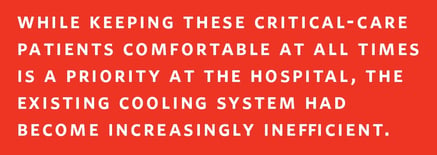As seen on pumpsandsystems.com – January 2017
Pumps played a key role in the facility’s energy efficiency improvements.
By Brent Ross
Armstrong Fluid Technology
Gaining an average of $200,000 a year in heating, ventilation and air-conditioning (HVAC) energy savings would be important to any organization. For Methodist Dallas Medical Center (MDMC), it means being able to direct more money toward critical—even lifesaving—health services.
Serving North Texas since 1927, MDMC includes a Level III Neonatal Intensive Care Unit and the Methodist Dallas Transplant Institute, one of the largest and most active multi-organ transplant centers in the Southwest U.S. While keeping these critical-care patients comfortable at all times is a priority at the hospital, the existing cooling system had become increasingly inefficient.
A 2012 review of the mechanical system indicated that opportunities for energy savings were available and that some components, including a 30-year-old cooling tower and a 25-year-old chiller, were outdated. Thee review also revealed that the original installation included piping irregularities that led to inefficient operations.
Based, in part, on the review’s findings, facility personnel decided to upgrade the HVAC system.
The Solution
With the goal of upgrading to a more energy-
efficient system, the MDMC facility managers met with RushCo Energy Specialists, an energy optimization contractor in the region. In addition to recommending the installation of a new chiller and cooling tower, RushCo recommended converting the system to a variable speed format, featuring new chilled water and condenser water pumps controlled by an integrated plant controller (IPC).
The contractor advised that a new variable speed pumping system would provide the hospital with significant cost savings. According to Tim Rusher at RushCo Energy Specialists, his company had used the proposed chilled water pumps for years and was comfortable recommending them and the IPC, which was made by the same company.
Although the facility managers were interested in the estimated energy savings, they were concerned about the equipment’s upfront costs and skeptical that the proposed technology could provide the proposed improvements. is was the hospital’s first exposure to variable speed technology.
To address their concerns, the pump and IPC manufacturer provided a written commitment regarding the system’s performance. With that assurance in hand, the hospital agreed to the proposed system.
The facility managers had never worked with vertical in-line (VIL) pumps, but based on the recommendation from the contractor, they agreed to design the system around a specific type of VIL pumps.
Because the old equipment had to be removed and preparations had to be made to accept the new equipment, the retrofit project involved several weeks of on-site work. is prep work included cutting a hole to install the new chiller. The final system included a new cooling tower, a new chiller, improved piping and the following key components:
- three 250-horsepower (hp) VIL pumps to serve the chilled water system
- five 100-hp VIL pumps to serve a condenser water system
- and IPC
The Results
The installation was completed in late March 2012, and the system performed reliably from the outset. In April, the first month of operation, the hospital saved more than $15,000 compared with April 2011 through reduced energy costs that could be directly traced to the upgraded HVAC system.
Managers knew the real test of energy efficiency would come in June, July and August, the hottest months of the summer. Savings for those three months of operations, compared with the prior year of operations, were $15,000 in June, $50,000 in July and $27,000 in August.
From the installation in April 2012 through the end of 2015, MDMC has realized more than $600,000 in energy savings, an average of more than $200,000 a year.
The new system not only saves energy but also creates a more comfortable environment for hospital staff and patients. The hospital has experienced sharp reductions in "hot calls," and the maintenance staff has commented that the new system is easier to operate, monitor and adjust.
The dramatic improvements in energy efficiency because of these updates have allowed the hospital to invest some of the savings into critical care programs that benefit the entire community.




